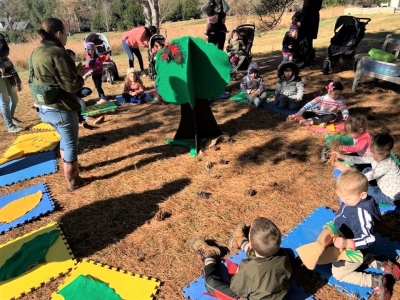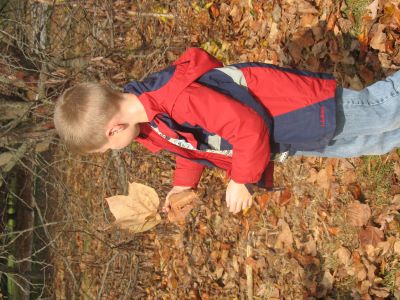 by Candace Lutzow-Felling, Director of Education
by Candace Lutzow-Felling, Director of Education
Blandy’s education team offers programs for preschool students as well as students in kindergarten through grade 12. Preschool-age children especially are naturally curious about their world, constantly exploring, questioning, and testing their environment and their place in it. These initial developmental years have a significant impact on a child’s maturing brain and their cognitive, social, and physical development.
By the time children begin kindergarten, typically at the age of five, they are expected to be “ready to learn.” Readiness to learn includes the ability to learn independently and in social groups; to be able to monitor and moderate one’s behavior (to some extent); to recognize numbers, letters and words (not necessarily to read and write yet, but to know what a number, letter, or word is); to have some control over their bodies and senses (hand-eye coordination, movement in various directions); and, to be able to focus and pay attention (albeit for short periods of time; this skill progresses as the child ages).
Our preschool programs are designed to develop these “readiness to learn” skills and are based on early learning guidelines developed by the Virginia Department of Education. At Blandy we encourage our young learners to explore their natural world by engaging in playful learning experiences, an approach supported by years of education and cognitive development research. Playful learning experiences build curiosity; creativity and imagination; and focus, memory, and adaptability.
 During our Early Explorers program, young learners discover that trees are home to many different animals. Sitting around our “discovery tree” each child is given a different felt animal; they listen to a poem with lots of animals mentioned in it. When they hear their animal mentioned they jump up and place it on the part of the tree where they think the animal would live. Outside we visit several trees and they look for evidence of animals in the trees. We explore how the animal might be using the tree: For food? A home? A place to sleep? Where on the tree are we finding evidence of animals: The trunk? Near the ground? On a branch? On the leaves? This is a fun seek-and find game that also teaches investigation skills and rudimentary ecology knowledge focused on the interdependence of plants and animals.
During our Early Explorers program, young learners discover that trees are home to many different animals. Sitting around our “discovery tree” each child is given a different felt animal; they listen to a poem with lots of animals mentioned in it. When they hear their animal mentioned they jump up and place it on the part of the tree where they think the animal would live. Outside we visit several trees and they look for evidence of animals in the trees. We explore how the animal might be using the tree: For food? A home? A place to sleep? Where on the tree are we finding evidence of animals: The trunk? Near the ground? On a branch? On the leaves? This is a fun seek-and find game that also teaches investigation skills and rudimentary ecology knowledge focused on the interdependence of plants and animals.
 Next, we explore our picnic grove woodland to find leaves of various shapes. Can we find a leaf shaped like a star (sweet gum)? Like a heart (red bud)? That looks like a cat’s face (tulip poplar)? Looking for shapes and patterns develops mathematical skills. We give our young scientists hand lenses so that they can more closely explore parts of a tree, the leaf surfaces, the flowers and fruits, the bark—this is a wonderful game of discovery that develops hand-eye coordination, and observation and investigation skills. Sharing and describing their discoveries builds communication and social interaction skills.
Next, we explore our picnic grove woodland to find leaves of various shapes. Can we find a leaf shaped like a star (sweet gum)? Like a heart (red bud)? That looks like a cat’s face (tulip poplar)? Looking for shapes and patterns develops mathematical skills. We give our young scientists hand lenses so that they can more closely explore parts of a tree, the leaf surfaces, the flowers and fruits, the bark—this is a wonderful game of discovery that develops hand-eye coordination, and observation and investigation skills. Sharing and describing their discoveries builds communication and social interaction skills.
At Blandy, we firmly believe that learning about our natural world is most effective when children learn outdoors and are given freedom to explore, ask questions, and discover driven by their own curiosity and guided by adults who also are curious about the natural world. Early childhood education research backs up our approach: there are positive connections between nature-based learning and improved social, emotional, and cognitive development. This year we are working on creating more programming for our preschool learners—stay tuned!
